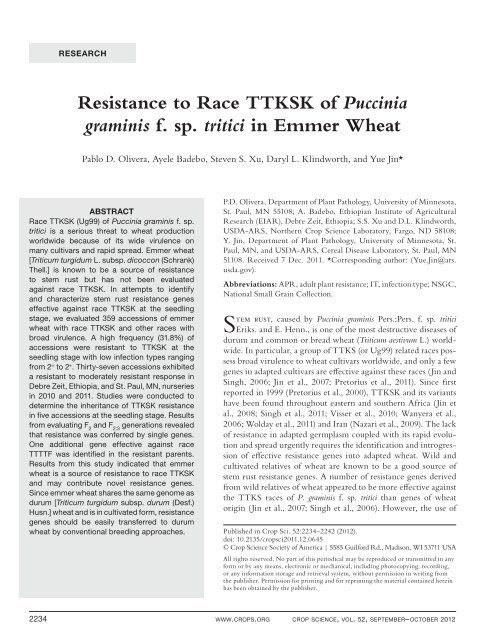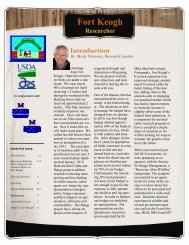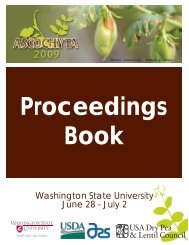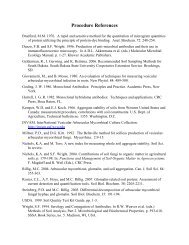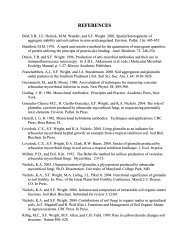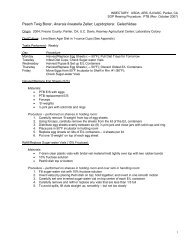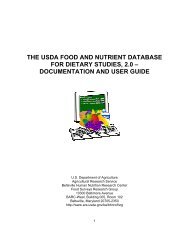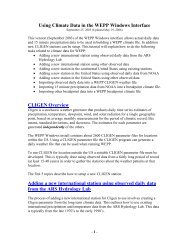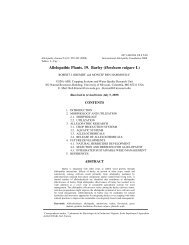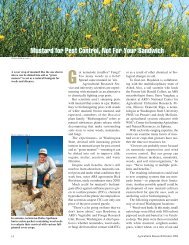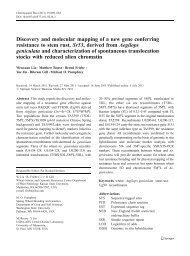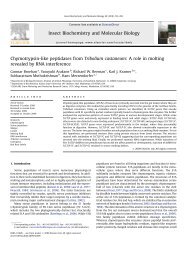Resistance to Race TTKSK of Puccinia graminis f. sp. tritici in Emmer ...
Resistance to Race TTKSK of Puccinia graminis f. sp. tritici in Emmer ...
Resistance to Race TTKSK of Puccinia graminis f. sp. tritici in Emmer ...
You also want an ePaper? Increase the reach of your titles
YUMPU automatically turns print PDFs into web optimized ePapers that Google loves.
RESEARCH<br />
<strong>Resistance</strong> <strong>to</strong> <strong>Race</strong> <strong>TTKSK</strong> <strong>of</strong> <strong>Pucc<strong>in</strong>ia</strong><br />
<strong>gram<strong>in</strong>is</strong> f. <strong>sp</strong>. <strong>tritici</strong> <strong>in</strong> <strong>Emmer</strong> Wheat<br />
Pablo D. Olivera, Ayele Badebo, Steven S. Xu, Daryl L. Kl<strong>in</strong>dworth, and Yue J<strong>in</strong>*<br />
ABSTRACT<br />
<strong>Race</strong> <strong>TTKSK</strong> (Ug99) <strong>of</strong> <strong>Pucc<strong>in</strong>ia</strong> <strong>gram<strong>in</strong>is</strong> f. <strong>sp</strong>.<br />
<strong>tritici</strong> is a serious threat <strong>to</strong> wheat production<br />
worldwide because <strong>of</strong> its wide virulence on<br />
many cultivars and rapid <strong>sp</strong>read. <strong>Emmer</strong> wheat<br />
[Triticum turgidum L. sub<strong>sp</strong>. dicoccon (Schrank)<br />
Thell.] is known <strong>to</strong> be a source <strong>of</strong> resistance<br />
<strong>to</strong> stem rust but has not been evaluated<br />
aga<strong>in</strong>st race <strong>TTKSK</strong>. In attempts <strong>to</strong> identify<br />
and characterize stem rust resistance genes<br />
effective aga<strong>in</strong>st race <strong>TTKSK</strong> at the seedl<strong>in</strong>g<br />
stage, we evaluated 359 accessions <strong>of</strong> emmer<br />
wheat with race <strong>TTKSK</strong> and other races with<br />
broad virulence. A high frequency (31.8%) <strong>of</strong><br />
accessions were resistant <strong>to</strong> <strong>TTKSK</strong> at the<br />
seedl<strong>in</strong>g stage with low <strong>in</strong>fection types rang<strong>in</strong>g<br />
from 2 = <strong>to</strong> 2 + . Thirty-seven accessions exhibited<br />
a resistant <strong>to</strong> moderately resistant re<strong>sp</strong>onse <strong>in</strong><br />
Debre Zeit, Ethiopia, and St. Paul, MN, nurseries<br />
<strong>in</strong> 2010 and 2011. Studies were conducted <strong>to</strong><br />
determ<strong>in</strong>e the <strong>in</strong>heritance <strong>of</strong> <strong>TTKSK</strong> resistance<br />
<strong>in</strong> fi ve accessions at the seedl<strong>in</strong>g stage. Results<br />
from evaluat<strong>in</strong>g F 2 and F 2:3 generations revealed<br />
that resistance was conferred by s<strong>in</strong>gle genes.<br />
One additional gene effective aga<strong>in</strong>st race<br />
TTTTF was identifi ed <strong>in</strong> the resistant parents.<br />
Results from this study <strong>in</strong>dicated that emmer<br />
wheat is a source <strong>of</strong> resistance <strong>to</strong> race <strong>TTKSK</strong><br />
and may contribute novel resistance genes.<br />
S<strong>in</strong>ce emmer wheat shares the same genome as<br />
durum [Triticum turgidum sub<strong>sp</strong>. durum (Desf.)<br />
Husn.] wheat and is <strong>in</strong> cultivated form, resistance<br />
genes should be easily transferred <strong>to</strong> durum<br />
wheat by conventional breed<strong>in</strong>g approaches.<br />
P.D. Olivera, Department <strong>of</strong> Plant Pathology, University <strong>of</strong> M<strong>in</strong>nesota,<br />
St. Paul, MN 55108; A. Badebo, Ethiopian Institute <strong>of</strong> Agricultural<br />
Research (EIAR), Debre Zeit, Ethiopia; S.S. Xu and D.L. Kl<strong>in</strong>dworth,<br />
USDA-ARS, Northern Crop Science Labora<strong>to</strong>ry, Fargo, ND 58108;<br />
Y. J<strong>in</strong>, Department <strong>of</strong> Plant Pathology, University <strong>of</strong> M<strong>in</strong>nesota, St.<br />
Paul, MN, and USDA-ARS, Cereal Disease Labora<strong>to</strong>ry, St. Paul, MN<br />
51108. Received 7 Dec. 2011. *Corre<strong>sp</strong>ond<strong>in</strong>g author: (Yue.J<strong>in</strong>@ars.<br />
usda.gov).<br />
Abbreviations: APR, adult plant resistance; IT, <strong>in</strong>fection type; NSGC,<br />
National Small Gra<strong>in</strong> Collection.<br />
Stem rust, caused by <strong>Pucc<strong>in</strong>ia</strong> <strong>gram<strong>in</strong>is</strong> Pers.:Pers. f. <strong>sp</strong>. <strong>tritici</strong><br />
Eriks. and E. Henn., is one <strong>of</strong> the most destructive diseases <strong>of</strong><br />
durum and common or bread wheat (Triticum aestivum L.) worldwide.<br />
In particular, a group <strong>of</strong> TTKS (or Ug99) related races possess<br />
broad virulence <strong>to</strong> wheat cultivars worldwide, and only a few<br />
genes <strong>in</strong> adapted cultivars are eff ective aga<strong>in</strong>st these races (J<strong>in</strong> and<br />
S<strong>in</strong>gh, 2006; J<strong>in</strong> et al., 2007; Pre<strong>to</strong>rius et al., 2011). S<strong>in</strong>ce fi rst<br />
reported <strong>in</strong> 1999 (Pre<strong>to</strong>rius et al., 2000), <strong>TTKSK</strong> and its variants<br />
have been found throughout eastern and southern Africa (J<strong>in</strong> et<br />
al., 2008; S<strong>in</strong>gh et al., 2011; Visser et al., 2010; Wanyera et al.,<br />
2006; Wolday et al., 2011) and Iran (Nazari et al., 2009). The lack<br />
<strong>of</strong> resistance <strong>in</strong> adapted germplasm coupled with its rapid evolution<br />
and <strong>sp</strong>read urgently requires the identifi cation and <strong>in</strong>trogression<br />
<strong>of</strong> eff ective resistance genes <strong>in</strong><strong>to</strong> adapted wheat. Wild and<br />
cultivated relatives <strong>of</strong> wheat are known <strong>to</strong> be a good source <strong>of</strong><br />
stem rust resistance genes. A number <strong>of</strong> resistance genes derived<br />
from wild relatives <strong>of</strong> wheat appeared <strong>to</strong> be more eff ective aga<strong>in</strong>st<br />
the TTKS races <strong>of</strong> P. <strong>gram<strong>in</strong>is</strong> f. <strong>sp</strong>. <strong>tritici</strong> than genes <strong>of</strong> wheat<br />
orig<strong>in</strong> (J<strong>in</strong> et al., 2007; S<strong>in</strong>gh et al., 2006). However, the use <strong>of</strong><br />
Published <strong>in</strong> Crop Sci. 52:2234–2242 (2012).<br />
doi: 10.2135/cropsci2011.12.0645<br />
© Crop Science Society <strong>of</strong> America | 5585 Guilford Rd., Madison, WI 53711 USA<br />
All rights reserved. No part <strong>of</strong> this periodical may be reproduced or transmitted <strong>in</strong> any<br />
form or by any means, electronic or mechanical, <strong>in</strong>clud<strong>in</strong>g pho<strong>to</strong>copy<strong>in</strong>g, record<strong>in</strong>g,<br />
or any <strong>in</strong>formation s<strong>to</strong>rage and retrieval system, without permission <strong>in</strong> writ<strong>in</strong>g from<br />
the publisher. Permission for pr<strong>in</strong>t<strong>in</strong>g and for repr<strong>in</strong>t<strong>in</strong>g the material conta<strong>in</strong>ed here<strong>in</strong><br />
has been obta<strong>in</strong>ed by the publisher.<br />
2234 WWW.CROPS.ORG CROP SCIENCE, VOL. 52, SEPTEMBER–OCTOBER 2012
esistance from cultivated wheat relatives may be preferred<br />
<strong>to</strong> hasten the <strong>in</strong>trogression process.<br />
<strong>Emmer</strong> wheat is a tetraploid (2n = 4x = 28, genome<br />
AABB) ancient hulled wheat. It is the oldest cultivated<br />
wheat (Kuckuck, 1970), and it is still grown <strong>in</strong> Ethiopia<br />
(Beteselassie et al., 2007), the Middle East, and Europe<br />
(Hammer and Perr<strong>in</strong>o, 1984; Stallknecht et al., 1996).<br />
<strong>Emmer</strong> wheat is known <strong>to</strong> be a good source <strong>of</strong> resistance<br />
<strong>to</strong> wheat diseases (Gras, 1980; Oliver et al., 2008), pests<br />
(Liu et al., 2005), and environmental stresses (Sayed,<br />
1985). <strong>Emmer</strong> wheat has contributed important genes for<br />
stem rust resistance, <strong>in</strong>clud<strong>in</strong>g Sr2 from Yaroslav emmer<br />
(McFadden, 1930) and Sr13 and Sr14 from Khapli (CItr<br />
4013) (Heermann and S<strong>to</strong>a, 1956). Reaction <strong>of</strong> emmer<br />
wheat <strong>to</strong> the recently emerged race <strong>TTKSK</strong> and its variants<br />
has not been characterized. The high variability observed<br />
<strong>in</strong> emmer wheat for agronomic and quality traits (Damania<br />
et al., 1992; Pfl üger et al., 2001; Sayed, 1985) opens the<br />
possibility for the identifi cation <strong>of</strong> new and diverse stem<br />
rust resistance genes if germplasm collections are extensively<br />
screened. In addition, s<strong>in</strong>ce emmer and durum wheat have<br />
the same genome constitution and share complete genomic<br />
compatibility (Yanchenko, 1985), resistance <strong>to</strong> stem rust<br />
from emmer could be easily <strong>in</strong>trogressed <strong>in</strong><strong>to</strong> durum wheat.<br />
To identify novel stem rust resistance genes eff ective aga<strong>in</strong>st<br />
<strong>TTKSK</strong> and its variants, we evaluated emmer wheat for<br />
resistance <strong>to</strong> stem rust races with broad virulence at the<br />
seedl<strong>in</strong>g and adult stage and conducted prelim<strong>in</strong>ary studies<br />
on the genetic basis <strong>of</strong> stem rust resistance.<br />
MATERIALS AND METHODS<br />
Germplasm<br />
A <strong>to</strong>tal <strong>of</strong> 359 accessions <strong>of</strong> emmer wheat deposited at the USDA-<br />
ARS National Small Gra<strong>in</strong> Collection (NSGC) (Aberdeen, ID)<br />
were evaluated <strong>in</strong> this study. Six emmer wheat accessions were<br />
selected for an <strong>in</strong>heritance and allelism study based on their reaction<br />
<strong>to</strong> races <strong>TTKSK</strong>, TRTTF, and TTTTF. Five accessions (PI<br />
101971, PI 193883, PI 217640, PI 298582, and PI 319869) were<br />
used as the resistant parents, and one accession (CItr 7966) was<br />
used as the susceptible parent. In <strong>to</strong>tal, 11 crosses were developed<br />
<strong>to</strong> <strong>in</strong>vestigate the number <strong>of</strong> genes conferr<strong>in</strong>g resistance or<br />
<strong>to</strong> determ<strong>in</strong>e the relationship between resistant parents. The F 1<br />
plants were grown and selfed <strong>to</strong> produce F 2 populations. Individual<br />
F 2 plants were then selfed <strong>to</strong> produce F 2:3 families.<br />
Inoculation, Incubation,<br />
and Disease Assessment<br />
Seedl<strong>in</strong>g Evaluations<br />
The entire emmer wheat collection <strong>of</strong> the NSGC was evaluated<br />
for reaction <strong>to</strong> three P. <strong>gram<strong>in</strong>is</strong> f. <strong>sp</strong>. <strong>tritici</strong> races with broad virulence<br />
and diff erent geographic orig<strong>in</strong>: <strong>TTKSK</strong> (Kenya), TRTTF<br />
(Yemen), and TTTTF (United States). Accessions exhibit<strong>in</strong>g resistance<br />
<strong>to</strong> race <strong>TTKSK</strong> were further characterized for their reaction<br />
<strong>to</strong> six additional U.S. races (TPMKC, RKQQC, RCRSC,<br />
QTHJC, QCCLC, and MCCFC). The race designation is based<br />
on the letter code nomenclature system (Roelfs and Martens,<br />
1988; Roelfs et al., 1993), modifi ed <strong>to</strong> further del<strong>in</strong>eate races <strong>in</strong><br />
the TTKS group (J<strong>in</strong> et al., 2008). Information about the stem<br />
rust isolates used <strong>in</strong> the disease phenotyp<strong>in</strong>g tests is summarized<br />
<strong>in</strong> Table 1. Five seedl<strong>in</strong>gs per accession were <strong>in</strong>oculated on fully<br />
expanded primary leaves 8 <strong>to</strong> 9 d after plant<strong>in</strong>g. Experimental<br />
procedures <strong>in</strong> <strong>in</strong>oculation and disease assessment were described<br />
by J<strong>in</strong> et al. (2007). Wheat cultivar McNair 701 (Cltr 15288) was<br />
used as the susceptible control. All the assessments were done<br />
with one replicate and were repeated once.<br />
Adult Evaluation<br />
All the emmer entries were evaluated for resistance <strong>in</strong> fi eld tests <strong>in</strong><br />
stem rust nurseries planted <strong>in</strong> St. Paul, MN, (April <strong>to</strong> July 2010)<br />
and <strong>in</strong> Debre Zeit, Ethiopia (June <strong>to</strong> Oc<strong>to</strong>ber 2010). Accessions<br />
rated as resistant with a maximum 30% stem rust severity and<br />
moderately susceptible <strong>in</strong>fection re<strong>sp</strong>onse or lower <strong>in</strong> the 2010<br />
Debre Zeit fi eld nursery were further evaluated <strong>in</strong> the Debre Zeit<br />
and St. Paul nurseries <strong>in</strong> May 2011 and July 2011, re<strong>sp</strong>ectively.<br />
In St. Paul, the nursery was <strong>in</strong>oculated with a composite <strong>of</strong> six<br />
U.S. races (TPMKC, RKQQC, RCRSC, QTHJC, QFCSC,<br />
and MCCFC). Accessions were planted <strong>in</strong> s<strong>in</strong>gle 1-m-row plots.<br />
In 2010, the Debre Zeit nursery was artifi cially <strong>in</strong>oculated with<br />
race <strong>TTKSK</strong> and a bulk <strong>of</strong> Ethiopian isolates (with unknown race<br />
identities) collected from durum l<strong>in</strong>es at the Debre Zeit Research<br />
Center at a ratio <strong>of</strong> 50:50 whereas <strong>in</strong> 2011 the <strong>in</strong>oculum was composed<br />
only <strong>of</strong> a bulk <strong>of</strong> Ethiopian isolates. Accessions were planted<br />
<strong>in</strong> double 1-m-row plots. In both nurseries, cont<strong>in</strong>uous rows <strong>of</strong><br />
stem rust <strong>sp</strong>reader (mixture <strong>of</strong> susceptible cultivars) were planted<br />
perpendicular <strong>to</strong> all entries <strong>to</strong> facilitate <strong>in</strong>oculum buildup and uniform<br />
dissem<strong>in</strong>ation. Spreader rows were artifi cially <strong>in</strong>oculated by<br />
needle <strong>in</strong>jection two <strong>to</strong> three times at a weekly <strong>in</strong>terval start<strong>in</strong>g at<br />
stem elongation (stage Zadoks 31) (Zadoks et al., 1974). Ured<strong>in</strong>io<strong>sp</strong>ores<br />
were su<strong>sp</strong>ended <strong>in</strong> distilled water plus one drop <strong>of</strong> Tween 20<br />
per 0.5 L <strong>of</strong> su<strong>sp</strong>ension and delivered with a hypodermic syr<strong>in</strong>ge<br />
<strong>in</strong><strong>to</strong> the base <strong>of</strong> the stems. Disease assessment was done at the<br />
s<strong>of</strong>t-dough stage <strong>of</strong> plant growth. Due <strong>to</strong> diff erences <strong>in</strong> maturity<br />
among emmer entries, three data po<strong>in</strong>ts were recorded at 1 and<br />
2 wk <strong>in</strong>terval start<strong>in</strong>g when the fi rst entries reach the s<strong>of</strong>t-dough<br />
stage. Plants were evaluated for their <strong>in</strong>fection re<strong>sp</strong>onse (pustule<br />
type and size) (Roelfs et al., 1992) and stem rust severity follow<strong>in</strong>g<br />
the modifi ed Cobb scale (Peterson et al., 1948). Infection<br />
re<strong>sp</strong>onses resistant and resistant <strong>to</strong> moderately resistant were considered<br />
as <strong>in</strong>dicative <strong>of</strong> resistance, and <strong>in</strong>fection re<strong>sp</strong>onses moderately<br />
resistant, moderately resistant <strong>to</strong> moderately susceptible, and<br />
moderately susceptible with a maximum 30% stem rust severity <strong>of</strong><br />
moderately or <strong>in</strong>termediate resistant.<br />
Inheritance and Allelism Studies<br />
To determ<strong>in</strong>e the genetic control <strong>of</strong> resistance <strong>to</strong> wheat stem<br />
rust at the seedl<strong>in</strong>g stage, crosses between resistant and susceptible<br />
emmer wheat accessions were evaluated. The F 1 plants<br />
were evaluated for re<strong>sp</strong>onse <strong>to</strong> race <strong>TTKSK</strong> <strong>to</strong> determ<strong>in</strong>e<br />
gene action. The F 2 populations were evaluated aga<strong>in</strong>st races<br />
<strong>TTKSK</strong>, TRTTF, and TTTTF <strong>to</strong> determ<strong>in</strong>e the <strong>in</strong>heritance<br />
<strong>of</strong> resistance. The F 2:3 families were evaluated only aga<strong>in</strong>st race<br />
<strong>TTKSK</strong>. The F 2:3 families from CItr 7966 × PI 217640 were<br />
also evaluated aga<strong>in</strong>st race TRTTF. Twenty plants from each<br />
F 2:3 family were tested. Accord<strong>in</strong>g <strong>to</strong> Hanson (1958), this F 2:3<br />
CROP SCIENCE, VOL. 52, SEPTEMBER–OCTOBER 2012 WWW.CROPS.ORG 2235
Table 1. Isolate designation, orig<strong>in</strong>, and virulence phenotype <strong>of</strong> <strong>Pucc<strong>in</strong>ia</strong> <strong>gram<strong>in</strong>is</strong> f. <strong>sp</strong>. <strong>tritici</strong> races used <strong>to</strong> evaluate resistance<br />
<strong>in</strong> emmer wheat (Triticum turgidum sub<strong>sp</strong>. dicoccon).<br />
<strong>Race</strong> Isolate Orig<strong>in</strong> Avirulence and virulence formula<br />
<strong>TTKSK</strong> 04KEN156/04 Kenya Sr24 36 Tmp/Sr5 6 7b 8a 9a 9b 9d 9e 9g 10 11 17 21 30 31 38 McN<br />
TRTTF 06YEM34-1 Yemen Sr8a 24 31/Sr5 6 7b 9a 9b 9d 9e 9g 10 11 17 21 30 36 38 McN Tmp<br />
TTTTF 02MN84A-1-2 United States Sr24 31/Sr5 6 7b 8a 9a 9b 9d 9e 9g 10 11 17 21 30 36 38 McN Tmp<br />
TPMKC 74MN1409 United States Sr6 9a 9b 24 30 31 38/Sr5 7b 8a 9d 9e 9g 10 11 17 21 36 McN Tmp<br />
RKQQC 99KS76A-1 United States Sr9e 10 11 17 24 30 31 38 Tmp/Sr5 6 7b 8a 9a 9b 9d 9g 21 36 McN<br />
RCRSC 77ND82A United States Sr6 8a 9e 11 24 30 31 38 Tmp/Sr5 7b 9a 9b 9d 9g 10 17 21 36 McN<br />
QTHJC 75ND717C United States Sr7b 9a 9e 24 30 31 38 36 Tmp/Sr5 6 8a 9b 9d 9g 10 11 17 McN<br />
QFCSC 06ND76C United States Sr6 7b 9b 9e 11 24 20 31 36 38 Tmp/Sr 5 8a 9a 9d 9g 10 17 21 McN<br />
QCCLC 07WA140-17-1 United States Sr6 7b 8a 9b 9d 9e 10 11 24 30 31 38 Tmp/Sr5 9a 9g 17 21 McN<br />
MCCFC 59KS19 United States Sr6 8a 9a 9b 9d 9e 11 21 24 30 31 36 38/Sr5 7b 9g 10 17 McN Tmp<br />
family size has a 99% probability <strong>of</strong> dist<strong>in</strong>guish<strong>in</strong>g between<br />
segregat<strong>in</strong>g and nonsegregat<strong>in</strong>g families for monogenic <strong>in</strong>heritance.<br />
The allelism tests <strong>in</strong>volved test<strong>in</strong>g F 2 populations derived<br />
from crosses between two resistant accessions. The χ 2 test was<br />
applied <strong>to</strong> determ<strong>in</strong>e the goodness-<strong>of</strong>-fi t <strong>to</strong> expected genetic<br />
ratios <strong>in</strong> the F 2 and F 2:3 generations. Additionally, χ 2 value also<br />
was calculated from a cont<strong>in</strong>gency table <strong>to</strong> assess the relationship<br />
<strong>of</strong> the reactions <strong>of</strong> F 2:3 families from the CItr 7966 × PI<br />
217640 cross <strong>to</strong> races <strong>TTKSK</strong> and TRTTF.<br />
RESULTS AND DISCUSSION<br />
Seedl<strong>in</strong>g Evaluation<br />
A high frequency <strong>of</strong> resistance <strong>to</strong> the three races evaluated at<br />
the seedl<strong>in</strong>g stage was observed <strong>in</strong> this emmer wheat collection,<br />
as 107 (31.8%), 123 (36.6%), and 148 (44.8%) accessions<br />
exhibited a resistant reaction <strong>to</strong> race <strong>TTKSK</strong>, TRTTF, and<br />
TTTTF, re<strong>sp</strong>ectively (Table 2). N<strong>in</strong>ety (25.1%) accessions<br />
were resistant <strong>to</strong> all three races. These results demonstrate<br />
that emmer wheat is a rich source <strong>of</strong> stem rust resistance.<br />
<strong>Resistance</strong> <strong>to</strong> wheat stem rust at the seedl<strong>in</strong>g stage was<br />
reported by Beteselassie et al. (2007) <strong>in</strong> Ethiopian emmer<br />
wheat, as 18 <strong>of</strong> 41 accessions were resistant <strong>to</strong> a bulk <strong>of</strong> six<br />
local isolates. The frequency <strong>of</strong> resistance <strong>to</strong> race <strong>TTKSK</strong><br />
observed <strong>in</strong> this emmer collection was similar <strong>to</strong> the one<br />
reported <strong>in</strong> wild emmer [T. turgidum sub<strong>sp</strong>. dicoccoides (Körn.<br />
ex Asch. & Graebn.) Thell.] (Olivera et al., 2009) and other<br />
cultivated tetraploids (Olivera et al., 2011). The characteristic<br />
<strong>in</strong>fection types <strong>of</strong> the emmer wheat resistant accessions <strong>to</strong> the<br />
three races ranged from 2 = <strong>to</strong> 2 + , and lower <strong>in</strong>fection types<br />
(ITs) (IT = 0; <strong>to</strong> 1) were observed <strong>in</strong> n<strong>in</strong>e (8.2%), 15 (13.6%),<br />
and 33 (30.0%) accessions <strong>to</strong> races <strong>TTKSK</strong>, TRTTF, and<br />
TTTTF, re<strong>sp</strong>ectively (data not shown). The predom<strong>in</strong>ance<br />
<strong>of</strong> <strong>in</strong>fection types rang<strong>in</strong>g from 2 = <strong>to</strong> 2 + appears <strong>to</strong> be a common<br />
feature <strong>in</strong> cultivated tetraploid wheat as similar results<br />
were observed <strong>in</strong> wild emmer, Polish, Oriental, and Pollard<br />
wheat (P. Olivera and Y. J<strong>in</strong>, unpublished data, 2011).<br />
Ten diff erent <strong>in</strong>fection type patterns were obta<strong>in</strong>ed<br />
when the 107 <strong>TTKSK</strong>-resistant accessions were<br />
characterized with six additional U.S. races (Table 3).<br />
Eighty-two (76.7%) accessions were resistant <strong>to</strong> all<br />
evaluated races whereas 13 accessions were susceptible <strong>to</strong><br />
Table 2. Number and percentage <strong>of</strong> emmer wheat (Triticum<br />
turgidum sub<strong>sp</strong>. dicoccon) accessions exhibit<strong>in</strong>g resistant,<br />
susceptible, and heterogeneous † reaction <strong>to</strong> <strong>Pucc<strong>in</strong>ia</strong><br />
<strong>gram<strong>in</strong>is</strong> f. <strong>sp</strong>. <strong>tritici</strong> races <strong>TTKSK</strong>, TRTTF, and TTTTF.<br />
<strong>TTKSK</strong> TRTTF TTTTF<br />
No. % No. % No. %<br />
Resistant 107 31.8 123 36.6 148 44.8<br />
Susceptible 215 64.0 199 59.2 176 53.3<br />
Heterogeneous 14 4.2 13 4.2 6 1.8<br />
† Accessions that conta<strong>in</strong>ed both resistant and susceptible plants.<br />
only one race. Six patterns were not duplicated. These<br />
results suggest that resistance <strong>to</strong> <strong>TTKSK</strong> <strong>in</strong> emmer wheat<br />
is not highly diverse but may be useful aga<strong>in</strong>st a broad<br />
<strong>sp</strong>ectrum <strong>of</strong> races. A higher level <strong>of</strong> diversity for stem rust<br />
resistance was observed <strong>in</strong> free thresh<strong>in</strong>g tetraploid wheat<br />
(McVey, 1991). In our study, we observed a lower level<br />
<strong>of</strong> diversity <strong>of</strong> stem rust resistance than that reported by<br />
McVey (1991), but this result may be expla<strong>in</strong>ed by the fact<br />
that we characterized the accessions that were resistant<br />
<strong>to</strong> race <strong>TTKSK</strong> only. When we evaluated the accessions<br />
susceptible <strong>to</strong> race <strong>TTKSK</strong> aga<strong>in</strong>st four additional U.S.<br />
races, we identifi ed over 30 <strong>in</strong>fection type patterns (data<br />
not shown). <strong>Emmer</strong> wheat has contributed race <strong>sp</strong>ecifi c<br />
stem rust resistance genes. In particular, Sr13 and Sr14<br />
were derived from Khapli emmer (Heermann and S<strong>to</strong>a,<br />
1956). These genes exhibit a moderate level <strong>of</strong> resistance<br />
(IT = 2 + ) and susceptibility (IT = 4) <strong>to</strong> race <strong>TTKSK</strong>,<br />
re<strong>sp</strong>ectively (J<strong>in</strong> et al., 2007). In addition, Sr13 exhibits<br />
a high reaction (IT = 3 + ) <strong>to</strong> race TRTTF (Olivera et al.,<br />
2012). The <strong>in</strong>fection types <strong>to</strong> races <strong>TTKSK</strong>, TRTTF,<br />
and TTTTF observed <strong>in</strong> the <strong>TTKSK</strong> resistant accessions<br />
<strong>in</strong>dicate that resistance genes present <strong>in</strong> these accessions<br />
were likely not Sr13 or Sr14.<br />
Adult Evaluation<br />
M<strong>in</strong>or diff erences <strong>in</strong> maturity were observed among the<br />
emmer entries. At both locations, about 80% <strong>of</strong> the accessions<br />
reached the s<strong>of</strong>t-dough stage <strong>of</strong> plant growth on<br />
the same week (90–97 d after plant<strong>in</strong>g). Five percent <strong>of</strong><br />
the entries reached the s<strong>of</strong>t-dough stage 8 <strong>to</strong> 10 d before<br />
2236 WWW.CROPS.ORG CROP SCIENCE, VOL. 52, SEPTEMBER–OCTOBER 2012
Table 3. Number and <strong>in</strong>fection type † patterns <strong>of</strong> emmer wheat (Triticum turgidum sub<strong>sp</strong>. dicoccon) accessions resistant <strong>to</strong><br />
race <strong>TTKSK</strong> <strong>of</strong> <strong>Pucc<strong>in</strong>ia</strong> <strong>gram<strong>in</strong>is</strong> f. <strong>sp</strong>. <strong>tritici</strong> at the seedl<strong>in</strong>g stage.<br />
Number <strong>of</strong> l<strong>in</strong>es <strong>TTKSK</strong> TRTTF TTTTF TPMKC<br />
<strong>Race</strong>s<br />
RKQQC RCRSC QTHJC QCCLC MCCFC<br />
82 L L L L L L L L L<br />
6 L H L L L L L L L<br />
4 L L H L L L L L L<br />
1 L L L H L L L L L<br />
1 L L L L L H L L L<br />
1 L L L L L L L L H<br />
1 L H H L L L L L L<br />
1 L H L H L L L L L<br />
1 L H H H H H L L L<br />
1 L L L H H H H H H<br />
† Infection types observed on seedl<strong>in</strong>gs at 14 d post<strong>in</strong>oculation us<strong>in</strong>g a 0 <strong>to</strong> 4 scale accord<strong>in</strong>g <strong>to</strong> Stakman et al. (1962), <strong>in</strong> which L stands for low <strong>in</strong>fection types 0, ;, 1, 2, or<br />
comb<strong>in</strong>ations and H stands for high <strong>in</strong>fection types 3 or 4.<br />
Table 4. Number and percentage <strong>of</strong> emmer wheat (Triticum turgidum sub<strong>sp</strong>. dicoccon) accessions † <strong>in</strong> fi eld evaluations <strong>in</strong><br />
Debre Zeit and St. Paul <strong>in</strong> 2010 and 2011 accord<strong>in</strong>g <strong>to</strong> <strong>in</strong>fection re<strong>sp</strong>onse and disease severity.<br />
2010 2011<br />
Disease evaluation Debre Zeit St. Paul Debre Zeit St. Paul<br />
Infection re<strong>sp</strong>onse ‡ Severity § No. % No. % No. % No. %<br />
R T–30 13 4.0 51 16.0 0 0.0 25 15.9<br />
R 31–60 0 0.0 0 0.0 0 0.0 0 0.0<br />
RMR–MRR T–30 11 3.4 25 7.9 5 3.2 22 14.0<br />
RMR–MRR 31–60 0 0.0 5 1.6 0 0.0 0 0.0<br />
MR T–30 27 8.3 21 6.6 19 12.1 18 11.5<br />
MR 31–60 0 0.0 8 2.5 0 0.0 0 0.0<br />
MRMS–MSMR T–30 74 22.7 17 5.3 20 12.7 11 7.0<br />
MRMS–MSMR 31–60 7 2.1 28 8.8 1 0.6 3 1.9<br />
MS T–30 32 9.8 6 1.9 6 3.8 6 3.8<br />
MS 31–60 10 3.1 25 7.9 1 0.6 14 8.9<br />
MS 61–100 0 0.0 3 0.9 0 0.0 0 0.0<br />
MSS–SMS T–30 40 12.3 1 0.3 11 7.0 6 3.8<br />
MSS–SMS 31–60 37 11.3 36 11.3 33 21.0 31 19.7<br />
MSS–SMS 61–100 0 0.0 4 1.3 0 0.0 0 0.0<br />
S T–30 21 6.4 0 0.0 9 5.7 0 0.0<br />
S 31–60 54 16.6 37 11.6 40 25.5 18 11.5<br />
S 61–100 0 0.0 51 16.0 9 5.7 1 0.6<br />
Total 326 100 318 100 157 100 157 100<br />
† Accessions characterized as resistant <strong>to</strong> moderately resistant with a maximum 30% stem rust severity and maximum moderately susceptible <strong>in</strong>fection re<strong>sp</strong>onse at the 2010<br />
Debre Zeit fi eld nursery were evaluated <strong>in</strong> 2011 <strong>in</strong> St. Paul and Debre Zeit.<br />
‡ Pustule type and size (Roelfs et al., 1992). R, resistant; RMR, resistant <strong>to</strong> moderately resistant; MRR, moderately resistant <strong>to</strong> resistant; MR, moderately resistant; MRMS,<br />
moderately resistant <strong>to</strong> moderately susceptible; MSMR, moderately susceptible <strong>to</strong> moderately resistant; MS, moderately susceptible; MSS, moderately susceptible <strong>to</strong><br />
susceptible; SMS, susceptible <strong>to</strong> moderately susceptible; S, susceptible.<br />
§ Stem rust severity follow<strong>in</strong>g the modifi ed Cobb scale (Peterson et al., 1948). T, traces.<br />
whereas 15 <strong>to</strong> 17% <strong>of</strong> the entries reached the s<strong>of</strong>t-dough<br />
stage 2 wk after the ma<strong>in</strong> group. A higher frequency <strong>of</strong><br />
susceptible accessions was observed <strong>in</strong> the late maturity<br />
group. <strong>Resistance</strong> <strong>to</strong> wheat stem rust at the adult stage was<br />
observed <strong>in</strong> emmer, as 164 (50.3%) and 161 (50.6%) accessions<br />
exhibited resistant <strong>to</strong> moderately resistant re<strong>sp</strong>onse<br />
<strong>in</strong> the 2010 Debre Zeit and St. Paul fi eld nurseries, re<strong>sp</strong>ectively<br />
(Table 4). Accessions characterized as resistant with<br />
a maximum 30% stem rust severity and maximum moderately<br />
susceptible <strong>in</strong>fection re<strong>sp</strong>onse <strong>in</strong> the Debre Zeit<br />
fi eld nursery <strong>in</strong> 2010 were further evaluated <strong>in</strong> both nurseries<br />
<strong>in</strong> 2011. Fifty-one (32.5%) and 85 (54.1%) accessions<br />
exhibited resistant <strong>to</strong> moderately resistant re<strong>sp</strong>onse <strong>in</strong> the<br />
2011 Debre Zeit and St. Paul fi eld nurseries, re<strong>sp</strong>ectively<br />
(Table 4). The higher disease pressure and the <strong>in</strong>oculum<br />
composition <strong>in</strong> the <strong>of</strong>f -season nursery (May 2011) <strong>in</strong><br />
Debre Zeit may expla<strong>in</strong> why only 32% <strong>of</strong> the accessions<br />
resistant <strong>in</strong> 2010 rema<strong>in</strong>ed resistant <strong>in</strong> the 2011 evaluations.<br />
The lower frequencies <strong>of</strong> resistance <strong>in</strong> Debre Zeit<br />
compared <strong>to</strong> St. Paul <strong>in</strong> 2010 and 2011 may <strong>in</strong>dicate the<br />
presence <strong>of</strong> races <strong>of</strong> P. <strong>gram<strong>in</strong>is</strong> f. <strong>sp</strong>. <strong>tritici</strong> <strong>in</strong> the Debre Zeit<br />
nursery that overcome resistance genes <strong>in</strong> emmer wheat<br />
that are eff ective aga<strong>in</strong>st U.S. races.<br />
CROP SCIENCE, VOL. 52, SEPTEMBER–OCTOBER 2012 WWW.CROPS.ORG 2237
Table 5. Stem rust reaction <strong>of</strong> emmer wheat (Triticum turgidum sub<strong>sp</strong>. dicoccon) accessions <strong>in</strong> fi eld evaluations <strong>in</strong> Debre Zeit<br />
and St. Paul <strong>in</strong> 2010 and 2011, and seedl<strong>in</strong>g evaluations <strong>to</strong> races <strong>TTKSK</strong>, TRTTF, TTTTF, TPMKC, RKQQC, QTHJC, and MCCFC<br />
<strong>of</strong> <strong>Pucc<strong>in</strong>ia</strong> <strong>gram<strong>in</strong>is</strong> f. <strong>sp</strong>. <strong>tritici</strong>.<br />
Field evaluation † Seedl<strong>in</strong>g evaluation ‡<br />
Debre Zeit St. Paul <strong>TTKSK</strong> TRTTF TTTTF TPMKC RKQQC QTHJC MCCFC<br />
Accession 2010 2011 2010 2011 04KEN156/04 06YEM34-1 01MN84A-1-2 74MN1409 99KSD76A-1 75ND717C 59KS19<br />
CItr 4013 40MSMR 30MRMS 30RMR 10RMR 33+ 4 3+ 3–3 2-; 2-; ;1-<br />
CItr 12213 10MRR 20MR 30MR 20MR 2N 22- ;2-N 2+ 2- 2-N 2-N<br />
CItr 12214 20MRMS 30MR 30MR 30MR 2N 22-; 2-N 22+N 2- 2-N 2–2N<br />
PI 41024 10R 20MR 40MRR 20MRR 2-N 2- 2-N 2-N 2- 2- 2-;N<br />
PI 94624 20MR 20 MS 10R 10R 22+ 4 ;N2- 31; ;N2 2- X<br />
PI 94625 20MR 10 MR 5R 10RMR 33- 4 ;13 31; X- ;C X-<br />
PI 94626 10MR 15 MRMS 20R 15MRR 22+ 3+ 1; 3+ ;C1- 2+ 2-;C<br />
PI 94635 10MR 10 MR, 20S 15RMR ;C2- 2=1; 2-; ;C2- ;C2- 2-; ;C<br />
PI 94656 10R 20MRMS 20RMR 20MRR 2-N 2- ;2- 2-N 2- 2- ;N2-<br />
PI 94665 20MRMS 30MSMR 20RMR 30MS 33+ 33+ 3+ 2-/3–3 2=; 3- 3–3<br />
PI 94674 30MRMS 30MS 30MR 5R ;2-N ;1 ;N1- 2-; ;CN 2-; ;CN1-<br />
PI 94747 5R 10MRR 30RMR 20RMR 2-N 2-; 2-; 2-N 2- 2-N ;N2-<br />
PI 101971 20R 20RMR 30MR 25MR 2-N 2-; ;2- 2-N 2- 2-;N 2-N<br />
PI 133134 5R 20MR 40MRR 20MR 22- 2-; ;2- 2-N 2-; 2-;N 2-;N<br />
PI 193879 20MR 20 MR, 40SMS 50MR 40MRMS 2-N 2 ;N 2-N 2-;N 2-; ;1<br />
PI 193880 30MSMR 20MR, 50SMS 40MRMS 30MRMS ;12- 2–2= ;2- ;12- ;12- ;2–1 ;1<br />
PI 193881 30MSMR 30MSS 40MR 30MR 3+ 3+3 33+ 3–3 3 3–2+ 3-<br />
PI 193882 40MRMS 30MR, 30S 50MRMS 30MS ;2- 2- ;2- 2- 22- 2-; ;1<br />
PI 193883 20MR 30MR, 40S 30MR 30MS ;2- 2–2 2- 2–2 2-; ;2- ;2-<br />
PI 197481 20MSMR 20MSMR 30MRR 20MR ; ;1- ;- ;C ;C ;2–1 ;CN<br />
PI 217637 10R 20MRMS 30RMR 20RMR 2 22- 2- 2-N 2- 2-; 2-;N<br />
PI 217639 5R 20RMR 30R 30RMR 2-N 2 2-;N 2-; 2-;N ;2- 2-N;<br />
PI 217640 10R 20RMR 20R 30R 2-N 2-; 2-;N 2-;N 2-; 2-; ;N2-<br />
PI 225332 10MR 20MSMR 10R 5R 3–2; 32; ;32 32; ;23 ;32 ;23-<br />
PI 248991 20RMR 25MRMS 50MR 30MR 2-N 2- 3- ;N2- 2- 2- 2-;N<br />
PI 254163 20MRMS 30MS 10R 10R 2-;N 4 3 3-; 2;N 3-;N 3-;<br />
PI 254165 10MSMR 30MSMR 5R 32; 3+2; 3–2; 3–2; 3–2; 3–2; 32;<br />
PI 254167 30MSMR 30MSMR 10R 10R 3 3+ ;N 2+3 3-; 32; 13;<br />
PI 254175 10MRMS 30MSMR 5R 5R 3–2; 4 32; 32; 23-; 32; ;3-<br />
PI 275996 20MRR 30MR 30R 20MR 2+3- 2- ;3- 2+3- 2- ;3- 2–2<br />
PI 298582 40MSMR 40MS 50MRMS 30MS 22+ 22+ 2 22+ 22+ 22+ 2-;<br />
PI 310471 20RMR 40MRMS 40MR 30MRR 2 22- 2- 2 2- 2- 2N<br />
PI 319869 30MS 30MSS 50MR 30MR 22- 2 2- 2–2 2- 2- 2-;<br />
PI 322232 20MR 30MRMS 40MR 30MR 22+ 22+ 2-; 2N 2- 2-N 2-;<br />
PI 324076 20RMR 30MR 40MRMS 20MR 2+ 22+ ;2- 2–2N 2-; 2-N 2-N<br />
PI 352548 20MR 20MR 20MR 20MSMR 22- 2 2 2-N 2- 2–2N 2-N<br />
PI 355477 20RMR 30MRMS 30MR 20R 2 2 ;C 2+2 2 2N 2-N<br />
PI 470739 20MRMS 10MR, 5MS 5R 5R 32 32 32; 2–2 2- 2- X-<br />
PI 532304 10MRMS 20MRMS 40RMR 20MR 3+ 3+ 3+3 3- 3 2+ 33-<br />
† Plants evaluated for <strong>in</strong>fection re<strong>sp</strong>onse (Roelfs et al., 1992) and severity (0–100) follow<strong>in</strong>g the modifi ed Cobb scale (Peterson et al., 1948). R, resistant; RMR, resistant<br />
<strong>to</strong> moderately resistant; MRR, moderately resistant <strong>to</strong> resistant; MR, moderately resistant; MRMS, moderately resistant <strong>to</strong> moderately susceptible; MSMR, moderately<br />
susceptible <strong>to</strong> moderately resistant; MS, moderately susceptible; MSS, moderately susceptible <strong>to</strong> susceptible; SMS, susceptible <strong>to</strong> moderately susceptible; S, susceptible.<br />
‡ Infection types observed on seedl<strong>in</strong>gs at 14 d post<strong>in</strong>oculation us<strong>in</strong>g a 0 <strong>to</strong> 4 scale accord<strong>in</strong>g <strong>to</strong> Stakman et al. (1962), where <strong>in</strong>fection types (ITs) <strong>of</strong> ;, 1, 2, or X are considered<br />
as a low IT and ITs <strong>of</strong> 3 or higher are considered as a high IT. N denotes excessive necrosis. “/” <strong>in</strong>dicated accessions were heterogeneous with dom<strong>in</strong>ant type given fi rst.<br />
Forty-one (26.1%) accessions were resistant <strong>to</strong><br />
moderately resistant <strong>in</strong> the two nurseries <strong>in</strong> 2011, and 39<br />
accessions exhibited a resistant <strong>to</strong> moderately resistant<br />
re<strong>sp</strong>onse <strong>in</strong> the Debre Zeit and St. Paul nurseries <strong>in</strong> 2010<br />
and 2011. Twenty-eight <strong>of</strong> these resistant accessions <strong>in</strong><br />
fi eld evaluations exhibited a resistant reaction <strong>to</strong> races<br />
<strong>TTKSK</strong>, TRTTF, TTTTF, TPMKC, RKQQC, QTHJC,<br />
and MCCFC <strong>in</strong> seedl<strong>in</strong>g evaluations (Table 5). Selection<br />
<strong>of</strong> resistance based on seedl<strong>in</strong>g tests can be eff ective, as<br />
resistance detected at the seedl<strong>in</strong>g stage rema<strong>in</strong>s eff ective<br />
at the adult stage. Four accessions (CItr 4013, PI 94665,<br />
PI 193881, and PI 532304) that were susceptible <strong>to</strong> races<br />
<strong>TTKSK</strong>, TRTTF, and TTTTF <strong>in</strong> seedl<strong>in</strong>g evaluations<br />
rema<strong>in</strong>ed resistant <strong>to</strong> moderately resistant across the two<br />
2238 WWW.CROPS.ORG CROP SCIENCE, VOL. 52, SEPTEMBER–OCTOBER 2012
Table 6. Disease reaction <strong>of</strong> F 1 plants and segregation <strong>of</strong> F 2 populations <strong>of</strong> various crosses <strong>of</strong> emmer wheat (Triticum turgidum<br />
sub<strong>sp</strong>. dicoccon) <strong>to</strong> race <strong>TTKSK</strong> <strong>of</strong> <strong>Pucc<strong>in</strong>ia</strong> <strong>gram<strong>in</strong>is</strong> f. <strong>sp</strong>. <strong>tritici</strong>.<br />
Cross †<br />
F plants 1 F plants<br />
2<br />
No. plants tested Infection type Resistant (R) Susceptible (S) Ratio tested (R:S) χ2 p-value<br />
CItr 7966 (S) × PI 101971 (R) 2 2 + 3− 81 24 3:1 0.257 0.612<br />
CItr 7966 (S) × PI 193883 (R) 2 3/3 + 31 73 1:3 1.282 0.258<br />
CItr 7966 (S) × PI 217640 (R) 2 2 + 92 29 3:1 0.069 0.793<br />
CItr 7966 (S) × PI 298582 (R) 2 4 20 92 1:3 3.048 0.081<br />
CItr 7966 (S) × PI 319869 (R) 2 3/33 + 25 98 1:3 1.434 0.231<br />
PI 101971 (R) × PI 217640 (R) 2 2−N 112 0 – – –<br />
PI 193883 (R) × PI 298582 (R) 2 2 105 0 – – –<br />
PI 193883 (R) × PI 319869 (R) 2 2− 145 0 – – –<br />
PI 319869 (R) × PI 298592 (R) 2 2 + 132 0 – – –<br />
PI 217640 (R) × PI 193883 (R) 2 2 + 101 6 13:3 0.075 0.784<br />
PI 298582 (R) × PI 101971 (R) 2 22 + 146 6 13:3 1.772 0.183<br />
† Female parent × male parent; (R) and (S) <strong>in</strong>dicate the resistant and susceptible parent, re<strong>sp</strong>ectively.<br />
evaluations performed at the adult stage (Table 5). These<br />
results may <strong>in</strong>dicate the presence <strong>of</strong> genes for adult plant<br />
resistance (APR) <strong>in</strong> these accessions. Sr2, an important gene<br />
for stem rust resistance (McIn<strong>to</strong>sh, 1988) was transferred <strong>to</strong><br />
hexaploid wheat from Yaroslav emmer (McFadden, 1930).<br />
Sr2 is reported <strong>in</strong> association with pseudo-black chaff , a<br />
black pigmentation that develops <strong>in</strong> the glumes and around<br />
stem <strong>in</strong>ternodes (Hare and McIn<strong>to</strong>sh, 1979). Pseudo-black<br />
chaff and black <strong>in</strong>ternode were observed <strong>in</strong> a number <strong>of</strong><br />
emmer accessions (PI 94624, PI 94625, PI 94626, PI 94674,<br />
PI 225332, PI 248991, PI 254163, PI 254165, PI 254167,<br />
PI 254175, PI 352548, and PI 532304). These accessions<br />
are be<strong>in</strong>g <strong>in</strong>vestigated further for the presence <strong>of</strong> Sr2 based<br />
on stem rust evaluations <strong>in</strong> seedl<strong>in</strong>g and adult plant stages<br />
as well as available markers (Mago et al., 2011). Accessions<br />
CItr 4013, PI 94665, and PI 193881 did not exhibit the<br />
Sr2 phenotype. Additional data are needed <strong>to</strong> confi rm the<br />
presence <strong>of</strong> APR genes <strong>in</strong> these accessions and determ<strong>in</strong>e<br />
the genetic relationship between these genes and Sr2.<br />
Inheritance and Allelism Studies<br />
The <strong>in</strong>fection types di<strong>sp</strong>layed by the F 1 plants (IT = 2 + <strong>to</strong> 2 + 3 − )<br />
from the crosses between the resistant accessions PI 101971<br />
and PI 217640 and the segregation ratios observed <strong>in</strong> the<br />
result<strong>in</strong>g F 2 progeny (fi t <strong>to</strong> a 3:1 ratio for resistant:susceptible)<br />
<strong>in</strong>dicate that <strong>in</strong> both accessions, seedl<strong>in</strong>g resistance <strong>to</strong> race<br />
<strong>TTKSK</strong> was controlled by a s<strong>in</strong>gle gene with partial dom<strong>in</strong>ance<br />
eff ect (Table 6). On the other hand, F 1 plants from the<br />
crosses between resistant accessions PI 193883, PI 298582,<br />
and PI 319869 and susceptible accessions exhibited ITs (3/33 +<br />
<strong>to</strong> 4) that were similar <strong>to</strong> the susceptible parent (Table 6).<br />
The number <strong>of</strong> resistant:susceptible plants <strong>in</strong> F 2 fi t a 1:3 ratio<br />
(Table 6), <strong>in</strong>dicat<strong>in</strong>g that resistance <strong>to</strong> race <strong>TTKSK</strong> <strong>in</strong> accessions<br />
PI 193883, PI 298582, and PI 319869 was controlled<br />
by a s<strong>in</strong>gle recessive gene. In the F 2:3 generation, the populations<br />
segregated <strong>in</strong> a 1:2:1 ratio for homozygous resistant:se<br />
gregat<strong>in</strong>g:homozygous susceptible families, confi rm<strong>in</strong>g that<br />
a s<strong>in</strong>gle gene conferred resistance <strong>to</strong> race <strong>TTKSK</strong> (Table 7).<br />
The simple <strong>in</strong>heritance <strong>of</strong> <strong>TTKSK</strong> resistance <strong>in</strong> the fi ve resistant<br />
emmer parents should simplify the transfer <strong>of</strong> resistance<br />
<strong>to</strong> durum and bread wheat. Accessions carry<strong>in</strong>g the partially<br />
dom<strong>in</strong>ant gene (PI 101971 and PI 217640) exhibited a higher<br />
level <strong>of</strong> resistance at the adult stage compar<strong>in</strong>g <strong>to</strong> the accessions<br />
that carry the recessive gene (PI 193883, PI 298582,<br />
and PI 319869) (Table 5). Five emmer accessions (CItr 12213,<br />
PI 41024, PI 94747, PI 133134, and PI 217639) exhibited a<br />
similar <strong>in</strong>fection type pattern at the seedl<strong>in</strong>g stage and a level<br />
<strong>of</strong> resistance <strong>in</strong> fi eld evaluations that is comparable <strong>to</strong> the one<br />
observed <strong>in</strong> accessions PI 101971 and PI 217640 (Table 5).<br />
These accessions may carry the same resistance gene eff ective<br />
aga<strong>in</strong>st <strong>TTKSK</strong>. All these accessions are good candidates for<br />
use <strong>in</strong> wheat breed<strong>in</strong>g programs.<br />
In the allelism test, the F 2 population derived from<br />
the cross between the two resistant accessions carry<strong>in</strong>g<br />
partially dom<strong>in</strong>ant genes (PI 101971 and PI 217640)<br />
produced only resistant progeny <strong>to</strong> race <strong>TTKSK</strong> (Table<br />
6). This <strong>in</strong>dicated that the accessions carried resistance<br />
alleles that were allelic or diff erent genes that are l<strong>in</strong>ked<br />
<strong>to</strong> each other. A similar result was observed <strong>in</strong> the F 2<br />
populations derived from crosses between the three<br />
resistant accessions carry<strong>in</strong>g recessive genes (PI 193883, PI<br />
298582, and PI 319869). On the other hand, segregation<br />
<strong>in</strong> F 2 populations derived from crosses between the<br />
resistant accessions carry<strong>in</strong>g dom<strong>in</strong>ant and recessive genes<br />
(PI 217640 × PI 193883, and PI 298582 × PI 101971) fi t<br />
a 13:3 ratio for resistant and susceptible plants (Table 6).<br />
This <strong>in</strong>dicated that the dom<strong>in</strong>ant and recessive resistance<br />
genes segregated <strong>in</strong>dependently. Beteselassie et al. (2007)<br />
also reported the presence <strong>of</strong> diverse stem rust resistance<br />
genes <strong>in</strong> a group <strong>of</strong> 18 Ethiopian emmer wheat accessions.<br />
Genetic diversity for stem rust resistance has also been<br />
observed <strong>in</strong> wild emmer, <strong>in</strong> which six stem rust resistant<br />
accessions were postulated <strong>to</strong> each carry a diff erent gene<br />
(Bai and Knott, 1994).<br />
To identify additional stem rust resistance genes <strong>in</strong><br />
the selected resistant parents, we evaluated the F 2 progeny<br />
CROP SCIENCE, VOL. 52, SEPTEMBER–OCTOBER 2012 WWW.CROPS.ORG 2239
Table 7. Segregation <strong>of</strong> F 2:3 families <strong>of</strong> various crosses <strong>of</strong> emmer wheat (Triticum turgidum sub<strong>sp</strong>. dicoccon) <strong>to</strong> race <strong>TTKSK</strong> <strong>of</strong><br />
<strong>Pucc<strong>in</strong>ia</strong> <strong>gram<strong>in</strong>is</strong> f. <strong>sp</strong>. <strong>tritici</strong>.<br />
Cross † <strong>Race</strong><br />
for their reaction <strong>to</strong> races TRTTF and TTTTF. No<br />
additional resistance gene was identifi ed when crosses<br />
were evaluated aga<strong>in</strong>st race TRTTF (Table 8). The χ 2<br />
value obta<strong>in</strong>ed from the cont<strong>in</strong>gency table <strong>in</strong>dicated a<br />
signifi cant association <strong>in</strong> the reaction <strong>to</strong> races <strong>TTKSK</strong> and<br />
TRTTF <strong>in</strong> the F 2:3 families from the cross CItr 7966 × PI<br />
217640 (p = 1.40 −39 ). In accession PI 319869, resistance <strong>to</strong><br />
TRTTF was conferred by a s<strong>in</strong>gle dom<strong>in</strong>ant gene (Table<br />
8). This gene may be diff erent from the one eff ective<br />
aga<strong>in</strong>st race <strong>TTKSK</strong> (recessive gene) or may <strong>in</strong>dicate a<br />
change <strong>in</strong> the dom<strong>in</strong>ance relationship <strong>in</strong> the resistance<br />
gene. Kolmer and Dyck (1994) reported a change <strong>in</strong> the<br />
expression <strong>of</strong> resistance <strong>in</strong> Thatcher l<strong>in</strong>es from completely<br />
dom<strong>in</strong>ant <strong>to</strong> recessive when <strong>Pucc<strong>in</strong>ia</strong> <strong>tritici</strong>na isolates<br />
were homozygous or heterozygous for avirulence. Two<br />
resistance genes eff ective aga<strong>in</strong>st race TTTTF were<br />
identifi ed <strong>in</strong> each <strong>of</strong> the fi ve resistant parents. Progenies<br />
segregated <strong>in</strong> a 15:1 or 13:3 ratio for resistant:susceptible<br />
F 2 plants, <strong>in</strong>dicat<strong>in</strong>g the presence <strong>of</strong> two dom<strong>in</strong>ant genes<br />
or one dom<strong>in</strong>ant and one recessive gene, <strong>to</strong> race TTTTF<br />
(Table 8). The existence <strong>of</strong> a number <strong>of</strong> stem rust resistance<br />
genes appears <strong>to</strong> be a common feature <strong>of</strong> tetraploid wheat<br />
as accessions with multiple stem rust resistance genes have<br />
been described <strong>in</strong> emmer wheat Khapli (Sr13 and Sr14)<br />
(Heermann and S<strong>to</strong>a, 1956), wild emmer (Knott et al.,<br />
2005; Olivera et al., 2011), and Persian [Triticum turgidum<br />
sub<strong>sp</strong>. carthlicum (Nevski) Á. Löve & D. Löve] and Pollard<br />
(T. turgidum sub<strong>sp</strong>. turgidum) wheat (Olivera et al., 2011).<br />
The use <strong>of</strong> races with diff erent virulence <strong>sp</strong>ectrum and<br />
orig<strong>in</strong> proved <strong>to</strong> be an effi cient <strong>to</strong>ol <strong>to</strong> identify multiple<br />
stem rust resistance genes <strong>in</strong> <strong>in</strong>dividual accessions.<br />
F 2:3 families ‡<br />
HR Seg. HS Ratio tested (HR:Seg:HS) p-value<br />
CItr 7966 (S) × PI 101971 (R) <strong>TTKSK</strong> 31 48 28 1:2:1 0.522<br />
CItr 7966 (S) × PI 217640 (R) <strong>TTKSK</strong> 37 80 33 1:2:1 0.644<br />
CItr 7966 (S) × PI 298582 (R) <strong>TTKSK</strong> 22 45 19 1:2:1 0.821<br />
CItr 7966 (S) × PI 319869 (R) <strong>TTKSK</strong> 22 38 19 1:2:1 0.843<br />
† Female parent × male parent; (R) and (S) <strong>in</strong>dicate the resistant and susceptible parent, re<strong>sp</strong>ectively.<br />
‡ HR, homozygous resistant; Seg., segregat<strong>in</strong>g; HS, homozygous susceptible.<br />
Table 8. Disease reaction <strong>of</strong> F 2 populations <strong>of</strong> various crosses <strong>of</strong> emmer wheat (Triticum turgidum sub<strong>sp</strong>. dicoccon) <strong>to</strong> races<br />
TRTTF and TTTTF <strong>of</strong> <strong>Pucc<strong>in</strong>ia</strong> <strong>gram<strong>in</strong>is</strong> f. <strong>sp</strong>. <strong>tritici</strong>.<br />
Cross †<br />
Resistant (R) Susceptible (S)<br />
TRTTF TTTTF<br />
Ratio tested<br />
(R:S) p-value Resistant Susceptible<br />
Ratio tested<br />
(R:S) p-value<br />
CItr 7966 (S) × PI 101971 (R) 78 32 3:1 0.322 129 12 15:1 0.267<br />
CItr 7966 (S) × PI 193883 (R) 28 45 1:3 0.008 117 15 13:3 0.030<br />
CItr 7966 (S) × PI 217640 (R) 49 17 3:1 0.145 209 34 13:3 0.057<br />
CItr 7966 (S) × PI 298582 (R) 11 40 1:3 0.571 104 23 13:3 0.853<br />
CItr 7966 (S) × PI 319869 (R) 38 11 3:1 0.507 125 15 13:3 0.015<br />
† Female parent × male parent; (R) and (S) <strong>in</strong>dicate the resistant and susceptible parent, re<strong>sp</strong>ectively.<br />
CONCLUSIONS<br />
The results <strong>of</strong> this study demonstrate that emmer wheat<br />
could serve as a source <strong>of</strong> resistance <strong>to</strong> race <strong>TTKSK</strong>. A<br />
number <strong>of</strong> accessions exhibited a resistant re<strong>sp</strong>onse <strong>in</strong> fi eld<br />
evaluations and resistant reaction <strong>to</strong> race <strong>TTKSK</strong> and all the<br />
races evaluated at the seedl<strong>in</strong>g stage (Table 5). These accessions<br />
can provide with resistance genes that are eff ective<br />
aga<strong>in</strong>st <strong>TTKSK</strong> and other races with broad virulence. Two<br />
genes eff ective aga<strong>in</strong>st race <strong>TTKSK</strong> have been identifi ed <strong>in</strong><br />
this study. In particular, the partially dom<strong>in</strong>ant gene present<br />
<strong>in</strong> accessions PI 101971 and PI 217640 confers a high level <strong>of</strong><br />
resistance <strong>in</strong> fi eld evaluations. This gene is a good candidate<br />
for use <strong>in</strong> wheat breed<strong>in</strong>g programs. Further genetic studies<br />
are required <strong>to</strong> confi rm the presence <strong>of</strong> additional eff ective<br />
genes <strong>in</strong> the resistant accessions. Eff orts should be made <strong>to</strong><br />
<strong>in</strong>corporate these eff ective genes from emmer wheat <strong>in</strong><strong>to</strong><br />
adapted backgrounds. S<strong>in</strong>ce emmer wheat shares the same<br />
genome as durum wheat and is <strong>in</strong> cultivated form, resistance<br />
genes should be easily transferred <strong>to</strong> durum wheat by<br />
conventional breed<strong>in</strong>g approaches.<br />
Acknowledgments<br />
This research is funded by USDA-ARS and the Durable Rust<br />
<strong>Resistance</strong> <strong>of</strong> Wheat (DRRW), Cornell University. The authors<br />
acknowledge Lucy Wanschura, Sam Gale, and GebreHiwot<br />
Abraha for their technical assistance.<br />
References<br />
Bai, D., and D.R. Knott. 1994. Genetic studies <strong>of</strong> leaf and stem rust<br />
resistance <strong>in</strong> six accessions <strong>of</strong> Triticum turgidum var. dicoccoides.<br />
Genome 37:405–409. doi:10.1139/g94-057<br />
Beteselassie, N., C. F<strong>in</strong><strong>in</strong>sa, and A. Badebo. 2007. Sources<br />
<strong>of</strong> resistance <strong>to</strong> stem rust (<strong>Pucc<strong>in</strong>ia</strong> <strong>gram<strong>in</strong>is</strong> f. <strong>sp</strong>. <strong>tritici</strong>) <strong>in</strong><br />
2240 WWW.CROPS.ORG CROP SCIENCE, VOL. 52, SEPTEMBER–OCTOBER 2012
Ethiopian tetraploid wheat accessions. Genet. Resour. Crop<br />
Evol. 54:337–343. doi:10.1007/s10722-005-5561-6<br />
Damania, A.B., S. Hakim, and M.Y. Moualla. 1992. Evaluation <strong>of</strong><br />
variation <strong>in</strong> Triticum dicoccum for wheat improvement <strong>in</strong> stress<br />
environments. Hereditas 116:163–166.<br />
Gras, M.A. 1980. Disease resistance <strong>in</strong> wheat: I. T. dicoccum as<br />
a source <strong>of</strong> genetic fac<strong>to</strong>rs aga<strong>in</strong>st rust and mildew. Genet.<br />
Agrar. 34:123–132.<br />
Hammer, K., and P. Perr<strong>in</strong>o. 1984. Further <strong>in</strong>formation on farro<br />
(Triticum monococcum L. and Triticum dicoccum Schrank) <strong>in</strong> South<br />
Italy. Kulturpfl anze 32:143–151. doi:10.1007/BF02002075<br />
Hanson, W.D. 1958. M<strong>in</strong>imum family sizes for the plann<strong>in</strong>g <strong>of</strong><br />
genetic experiments. Agron. J. 51:711–715. doi:10.2134/agron<br />
j1959.00021962005100120005x<br />
Hare, R.A., and R.A. McIn<strong>to</strong>sh. 1979. Genetic and cy<strong>to</strong>genetic<br />
studies <strong>of</strong> durable adult-plant resistances <strong>in</strong> ‘Hope’ and related<br />
cultivars <strong>to</strong> wheat rusts. Z. Pfl anzenzuchtg. 83:350–367.<br />
Heermann, R.M., and T.E. S<strong>to</strong>a. 1956. New durum wheats resistant<br />
<strong>to</strong> 15B. N. Dakota Agric. Exp. Stn. Farm Res. 18:75–81.<br />
J<strong>in</strong>, Y., and R.P. S<strong>in</strong>gh. 2006. <strong>Resistance</strong> <strong>in</strong> U.S. wheat <strong>to</strong> recent<br />
eastern African isolates <strong>of</strong> <strong>Pucc<strong>in</strong>ia</strong> <strong>gram<strong>in</strong>is</strong> f. <strong>sp</strong>. <strong>tritici</strong> with<br />
virulence <strong>to</strong> resistance gene Sr31. Plant Dis. 90:476–480.<br />
doi:10.1094/PD-90-0476<br />
J<strong>in</strong>, Y., R.P. S<strong>in</strong>gh, R.W. Ward, R. Wanyera, M. K<strong>in</strong>yua, P.<br />
Njau, T. Fetch, Z.A. Pre<strong>to</strong>rius, and A. Yahyaoui. 2007.<br />
Characterization <strong>of</strong> seedl<strong>in</strong>g <strong>in</strong>fection types and adult plant<br />
<strong>in</strong>fection re<strong>sp</strong>onses <strong>of</strong> monogenic Sr gene l<strong>in</strong>es <strong>to</strong> race TTKS<br />
<strong>of</strong> <strong>Pucc<strong>in</strong>ia</strong> <strong>gram<strong>in</strong>is</strong> f. <strong>sp</strong>. <strong>tritici</strong>. Plant Dis. 91:1096–1099.<br />
doi:10.1094/PDIS-91-9-1096<br />
J<strong>in</strong>, Y., L.J. Szabo, Z.A. Pre<strong>to</strong>rius, R.P. S<strong>in</strong>gh, R. Ward, and T.<br />
Fetch, Jr. 2008. Detection <strong>of</strong> virulence <strong>to</strong> resistance gene Sr24<br />
with<strong>in</strong> race TTKS <strong>of</strong> <strong>Pucc<strong>in</strong>ia</strong> <strong>gram<strong>in</strong>is</strong> f. <strong>sp</strong>. <strong>tritici</strong>. Plant Dis.<br />
92:923–926. doi:10.1094/PDIS-92-6-0923<br />
Knott, D.R., D. Bai, and J. Zale. 2005. The transfer <strong>of</strong> leaf and stem<br />
rust resistance from wild emmer wheats <strong>to</strong> durum and common<br />
wheat. Can. J. Plant Sci. 85:49–57. doi:10.4141/P03-212<br />
Kolmer, J.A., and P.L. Dyck. 1994. Gene expression <strong>in</strong> the Triticum<br />
aestivum-<strong>Pucc<strong>in</strong>ia</strong> recondita f. <strong>sp</strong>. <strong>tritici</strong> gene-for-gene system.<br />
Phy<strong>to</strong>pathology 84:437–440. doi:10.1094/Phy<strong>to</strong>-84-437<br />
Kuckuck, H. 1970. Primitive wheats. In: OH Frankel and<br />
E. Bennett, edi<strong>to</strong>rs, Genetic resources <strong>in</strong> plants – Their<br />
exploration and conservation. F. A. Davis Company.<br />
Philadelphia, PA. p. 249–266.<br />
Liu, X.M., G.L. Brown-Guedira, J.H. Hatchett, J.O. Owuoche,<br />
and M.S. Chen. 2005. Genetic characterization and molecular<br />
mapp<strong>in</strong>g <strong>of</strong> a Hessian fl y-resistance gene transferred from T.<br />
turgidum s<strong>sp</strong>. dicoccum <strong>to</strong> common wheat. Theor. Appl. Genet.<br />
111:1308–1315. doi:10.1007/s00122-005-0059-3<br />
Mago, R., G. Brown-Guedira, S. Dreisigacker, J. Breen, Y. J<strong>in</strong>, R.<br />
S<strong>in</strong>gh, R. Appels, E.S. Lagudah, J. Ellis, and W. Spielmeyer.<br />
2011. An accurate DNA marker assay for stem rust resistance<br />
gene Sr2 <strong>in</strong> wheat. Theor. Appl. Genet. 122:735–744.<br />
doi:10.1007/s00122-010-1482-7<br />
McFadden, E.S. 1930. A successful transfer <strong>of</strong> emmer characters <strong>to</strong><br />
vulgare wheat. J. Am. Soc. Agron. 22:1020–1034. doi:10.2134/<br />
agronj1930.00021962002200120005x<br />
McIn<strong>to</strong>sh, R.A. 1988. The role <strong>of</strong> <strong>sp</strong>ecifi c genes <strong>in</strong> breed<strong>in</strong>g for durable<br />
stem rust resistance <strong>in</strong> wheat and triticale. In: N.W. Simmonds<br />
and S. Rajaram, edi<strong>to</strong>rs, Breed<strong>in</strong>g strategies for resistance <strong>to</strong> the<br />
rusts <strong>of</strong> wheat. CIMMYT, Mexico D.F., Mexico. p. 1–9.<br />
McVey, D.V. 1991. Reaction <strong>of</strong> a group <strong>of</strong> related wheat <strong>sp</strong>ecies (AABB<br />
genome and AABBDD) <strong>to</strong> stem rust. Crop Sci. 31:1145–1149.<br />
doi:10.2135/cropsci1991.0011183X003100050012x<br />
Nazari, K., M. Mafi , A. Yahyaoui, and R.P. Park. 2009. Detection <strong>of</strong><br />
wheat stem rust (<strong>Pucc<strong>in</strong>ia</strong> <strong>gram<strong>in</strong>is</strong> f. <strong>sp</strong>. <strong>tritici</strong>) race <strong>TTKSK</strong> (Ug99)<br />
<strong>in</strong> Iran. Plant Dis. 93:317. doi:10.1094/PDIS-93-3-0317B<br />
Oliver, R.E., X. Cai, R.W. Stack, T. Friesen, S. Halley, and S.S.<br />
Xu. 2008. Fusarium head blight resistance <strong>in</strong> tetraploid wheat<br />
(Triticum turgidum L.). Crop Sci. 48:213–222. doi:10.2135/<br />
cropsci2007.03.0129<br />
Olivera, P.D., Y. J<strong>in</strong>, A. Badebo, S. Xu, and D. Kl<strong>in</strong>dworth. 2011.<br />
<strong>Resistance</strong> <strong>to</strong> race <strong>TTKSK</strong> <strong>of</strong> <strong>Pucc<strong>in</strong>ia</strong> <strong>gram<strong>in</strong>is</strong> f. <strong>sp</strong>. <strong>tritici</strong> <strong>in</strong><br />
tetraploid wheat. Phy<strong>to</strong>pathology 101:S132.<br />
Olivera, P.D., Y. J<strong>in</strong>, M. Rouse, A. Badebo, T. Fetch, R.P. S<strong>in</strong>gh,<br />
and A. Yahyaoui. 2012. <strong>Race</strong>s <strong>of</strong> <strong>Pucc<strong>in</strong>ia</strong> <strong>gram<strong>in</strong>is</strong> f. <strong>sp</strong>. <strong>tritici</strong><br />
with comb<strong>in</strong>ed virulence <strong>to</strong> Sr13 and Sr9e <strong>in</strong> a fi eld stem rust<br />
screen<strong>in</strong>g nursery <strong>in</strong> Ethiopia. Plant Dis. 96:623–628.<br />
Olivera, P.D., M. Rouse, and Y. J<strong>in</strong>. 2009. <strong>Resistance</strong> <strong>to</strong> wheat stem rust<br />
<strong>in</strong> <strong>sp</strong>elt wheat, wild emmer and triticale. Phy<strong>to</strong>pathology 99:S97.<br />
Peterson, R.F., A.B. Campbell, and A.E. Hannah. 1948. A<br />
diagrammatic scale for estimat<strong>in</strong>g rust <strong>in</strong>tensity <strong>of</strong> leaves and<br />
stem <strong>of</strong> cereals. Can. J. Res. Sect. C 26:496–500. doi:10.1139/<br />
cjr48c-033<br />
Pfl üger, L.A., L.M. Martín, and J.B. Alvarez. 2001. Variation <strong>in</strong> the<br />
HMW and LMW luten<strong>in</strong> subunits from Spanish accessions <strong>of</strong><br />
emmer wheat (Triticum turgidum s<strong>sp</strong>. dicoccum Schrank). Theor.<br />
Appl. Genet. 102:767–772. doi:10.1007/s001220051708<br />
Pre<strong>to</strong>rious, Z.A., Y. J<strong>in</strong>, C.M. Bender, L. Herselman, and R.<br />
Pr<strong>in</strong>s. 2011. Seedl<strong>in</strong>g resistance <strong>to</strong> stem rust race Ug99 and<br />
marker analysis for Sr2, Sr24 and Sr31 <strong>in</strong> South African wheat<br />
cultivars and l<strong>in</strong>es. Euphytica doi:10.1007/s10681-011-0476-0<br />
Pre<strong>to</strong>rius, Z.A., R.P. S<strong>in</strong>gh, W.W. Wagoire, and T.S. Payne. 2000.<br />
Detection <strong>of</strong> virulence <strong>to</strong> wheat stem rust resistance genes Sr31<br />
<strong>in</strong> <strong>Pucc<strong>in</strong>ia</strong> <strong>gram<strong>in</strong>is</strong> f. <strong>sp</strong>. <strong>tritici</strong> <strong>in</strong> Uganda. Plant Dis. 84:2003.<br />
Roelfs, A.P., D.L. Long, and J.J. Roberts. 1993. <strong>Race</strong>s <strong>of</strong> <strong>Pucc<strong>in</strong>ia</strong><br />
<strong>gram<strong>in</strong>is</strong> <strong>in</strong> the United States dur<strong>in</strong>g 1992. Plant Dis. 77:1122–<br />
1125. doi:10.1094/PD-77-1122<br />
Roelfs, A.P., and J.W. Martens. 1988. An <strong>in</strong>ternational system <strong>of</strong><br />
nomenclature for <strong>Pucc<strong>in</strong>ia</strong> <strong>gram<strong>in</strong>is</strong> f. <strong>sp</strong>. <strong>tritici</strong>. Phy<strong>to</strong>pathology<br />
78:526–533. doi:10.1094/Phy<strong>to</strong>-78-526<br />
Roelfs, A.P., R.P. S<strong>in</strong>gh, and E.E. Saari. 1992. Rust diseases<br />
<strong>of</strong> wheat, concepts and methods <strong>of</strong> disease management.<br />
CIMMYT, Mexico D.F., Mexico.<br />
Sayed, H.I. 1985. Diversity <strong>of</strong> salt <strong>to</strong>lerance <strong>in</strong> germplasm collection<br />
<strong>of</strong> wheat (Triticum s<strong>sp</strong>.). Theor. Appl. Genet. 69:651–657.<br />
doi:10.1007/BF00251118<br />
S<strong>in</strong>gh, R.P., D.P. Hodson, J. Huerta-E<strong>sp</strong><strong>in</strong>o, Y. J<strong>in</strong>, S. Bhavani,<br />
P. Njau, S.A. Herrera-Foessel, P. S<strong>in</strong>gh, S. S<strong>in</strong>gh, and V.<br />
Gov<strong>in</strong>dan. 2011. The emergence <strong>of</strong> Ug99 races <strong>of</strong> the stem<br />
rust fungus is a threat <strong>to</strong> world wheat production. Annu.<br />
Rev. Phy<strong>to</strong>pathol. 49:465–481. doi:10.1146/annurevphy<strong>to</strong>-072910-095423<br />
S<strong>in</strong>gh, R.P., D.P. Hodson, Y. J<strong>in</strong>, J. Huerta-E<strong>sp</strong><strong>in</strong>o, M.G. K<strong>in</strong>yua,<br />
R. Wanyera, P. Njau, and R.W. Ward. 2006. Current status,<br />
likely migration and strategies <strong>to</strong> mitigate the threat <strong>to</strong> wheat<br />
production from race Ug99 (TTKS) <strong>of</strong> stem rust pathogen.<br />
CAB Rev. Per<strong>sp</strong>ect. Agric. Vet. Sci. Nutr. Nat. Res. 54:1–13.<br />
Stakman, E.C., D.M. Steward, and W.Q. Loeger<strong>in</strong>g. 1962.<br />
Identifi cation and physiologic races <strong>of</strong> <strong>Pucc<strong>in</strong>ia</strong> <strong>gram<strong>in</strong>is</strong> var. <strong>tritici</strong>.<br />
USDA-ARS E-617. U.S. Gov. Pr<strong>in</strong>t. Off ., Wash<strong>in</strong>g<strong>to</strong>n, DC.<br />
Stallknecht, G.F., K.M. Gilbertson, and J.E. Ranney. 1996.<br />
Alternative wheat cereals as food gra<strong>in</strong>s: E<strong>in</strong>korn, emmer,<br />
<strong>sp</strong>elt, kamut, and triticale. In: J. Janick, edi<strong>to</strong>r, Progress <strong>in</strong><br />
new crops. ASHS Press, Alexandria, VA. p. 156–170.<br />
CROP SCIENCE, VOL. 52, SEPTEMBER–OCTOBER 2012 WWW.CROPS.ORG 2241
Visser, B., L. Herselman, R.F. Park, H. Karaoglu, C.M. Bender,<br />
and Z.A. Pre<strong>to</strong>rius. 2010. Characterization <strong>of</strong> two new<br />
<strong>Pucc<strong>in</strong>ia</strong> <strong>gram<strong>in</strong>is</strong> f. <strong>sp</strong>. <strong>tritici</strong> races with<strong>in</strong> the Ug99 l<strong>in</strong>eage <strong>in</strong><br />
South Africa. Euphytica 179:119–127. doi:10.1007/s10681-<br />
010-0269-x<br />
Wanyera, R., M.G. K<strong>in</strong>yua, Y. J<strong>in</strong>, and R.P. S<strong>in</strong>gh. 2006. The<br />
<strong>sp</strong>read <strong>of</strong> stem rust caused by <strong>Pucc<strong>in</strong>ia</strong> <strong>gram<strong>in</strong>is</strong> f. <strong>sp</strong>. <strong>tritici</strong>,<br />
with virulence on Sr31 <strong>in</strong> wheat <strong>in</strong> Eastern Africa. Plant Dis.<br />
90:113. doi:10.1094/PD-90-0113A<br />
Wolday, A., T. Fetch, Jr., D. Hodson, W. Cao, and S. Briere. 2011.<br />
First report <strong>of</strong> <strong>Pucc<strong>in</strong>ia</strong> <strong>gram<strong>in</strong>is</strong> f. <strong>sp</strong>. <strong>tritici</strong> races with virulence<br />
<strong>to</strong> wheat stem rust resistance genes Sr31 and Sr24 <strong>in</strong> Eritrea.<br />
Plant Dis. 95:1591. doi:10.1094/PDIS-07-11-0582<br />
Yanchenko, I. 1985. A study <strong>of</strong> <strong>in</strong>ter<strong>sp</strong>ecifi c hybrids <strong>of</strong> Triticum<br />
durum Desf. × Triticum dicoccum (Schrank) Schuebl. and ways<br />
<strong>of</strong> us<strong>in</strong>g them <strong>in</strong> durum wheat breed<strong>in</strong>g. Naucho Tek. Eyul.<br />
Sibirskogo Old. Vashknil. 45:3–7.<br />
Zadoks, J.C., T.T. Chang, and C.F. Konzak. 1974. A decimal<br />
code for the growth stage <strong>of</strong> cereals. Weed Res. 14:415–421.<br />
doi:10.1111/j.1365-3180.1974.tb01084.x<br />
2242 WWW.CROPS.ORG CROP SCIENCE, VOL. 52, SEPTEMBER–OCTOBER 2012


